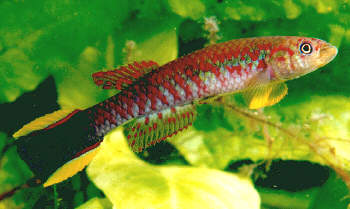Scriptaphyosemion brueningi (Roloff 1971)

Fayeh. Photo courtesy of Christian Cauvet.
| Meaning of Name |
After Christian Brünning, a German aquarist. |
| First Description |
|
| Size |
5 cm in males with females about a cm shorter. |
| Meristics |
D = 11-12, A = 15-16, D/A = 1/3-5, ll = 32-33 (Roloff 1971). |
| Karyotype |
n = 21, A = 22 (Grimm 1974). |
| Sub-Genus |
Scriptaphyosemion |
| Group |
A.liberiensis |
| Synonyms |
|
Populations
|
Benduma - Collected by Etzel & Putz in 1982 (EP 82 code). Biato - Collected by Etzel in 1978. Bomban - Collected north of this location by Etzel in 1978. Bomi Hills - Collected by Roloff in 1971. Fayeh - Collected by Busch & Hellner in 1989 (SL 89 code). Giema - Gema may be a corruption of this collection. Collected by Roloff in 1971. Collected in shallow water with moderate vegetation. Joru - Collected by Etzel in 1978. Lofa - Collected by Etzel in 1978. Perie - Collected by Busch & Hellner in 1989 (SL 89 code). Serfalu - Collected by Etzel in 1978. |
|
Type Locality |
A pool which was connected to a stream close to Giema, Sierra Leone. |
| Distribution |
Found in middle sections of the drainages of the Mano, Moa & Sewa Rivers of southeastern Sierra Leone & the middle Mano & Lofa Rivers of western Liberia. |
| Habitat |
Swampy areas of rainforest streams & brooks. Also
found in forested savannah. |
| Distinguishing Characteristics | |
| Colour/Pattern Variability | |
| History |
Discovered by E.Roloff in 1970/71 ? The SL code was imported to the BKA around 1970/72. Possibly there first introduction into the BKA. |
| Breeding Notes |
Eggs are laid in top & bottom mops or in fine leaved plants where they will grow on with the parents. Incubation takes around 14 days.Young fish reach maturity after about 5 months.(Wildekamp. A World of Killies). When the code SL 15
was first distributed in the BKA (around 1970-72) it was observed that they preferred
the bottom area of the tank to lay eggs in but the occaisional egg could be found
in the mid level in floating mops. Eggs were found to be small & difficult
to find. They proved delicate with many turning fungussed when removed. The natural
method of leaving the eggs to hatch with the parents proved a better method. Young
fish/fry could be 'dipped' or ladelled out into there own tank for growing on.
Water composition should be the same as the parents tank. Fry were small on hatching
& required infusoria as a first food. Peter
Schneider writes in BKA Newsletter No. 266/267, October/November 1987. |
| Diameter of Egg | |
| Remarks |
This sp. seems to not eat eggs or fry. |